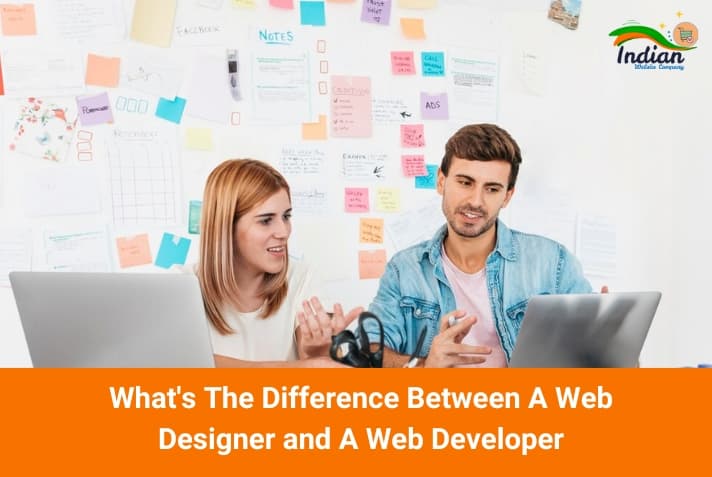What's The Difference Between A Web Designer and A Web Developer

Web designers and web developers are responsible for all of the attractive and powerful websites you see on the internet. Web developers and web designers are commonly used interchangeably by people who are new to web development, however they are two distinct professions. Small businesses that aren't dedicated to web sites don't hire web designers; instead, they ask their web developer to design and develop the entire site; however, large businesses that rely heavily on their website hire both web designers and web developers to create a beautiful, interactive, and powerful site.
In this post, we've discussed the differences between a Web Designer and a Webe Developer, as well as the roles they play in the development of a website.
Should I Hire a Web Developer or a Web Designer?
Before we produce or develop something in the industry, we first create a blueprint and a proper plan for how things will proceed when employees work on that project. A website designer is the individual who comes up with the concept and layout for the entire website. They establish a blueprint for how and where each part of the website will go, as well as the overall appearance and feel of the website. A web designer can be thought of as an architect who creates a plan or layout for our website.
Web designers are sometimes overlooked, yet they play an important part in web development. It is a web designer's job to create a user-friendly web page and give the greatest environment for the user so that they stay connected to your website at all times.
The primary responsibility of a web designer is to create or imagine an interface that will attract users' attention and that is rational enough to be executed by web developers. A web designer, like a web developer, does not need expert knowledge of how web sites work or are built; all they need to do is design a web site that will attract more users to their site. However, they should have prior knowledge of how web sites work and whether or not the web site they are designing can be built.
The Functions of a Web Designer
A Web Designer creates the website's blueprint using software such as Adobe Photoshop, Framer, or Sketch.
Graphic and logo design skills are required of a web designer.
A web designer must be able to create a website with a rich user interface while keeping it simple.
They must also design the right slot in which all of the website's features, such as photographs, buttons, and other general forms, will fit.
A web designer must keep up with the latest trends in the industry and try to incorporate new features into the website's design.
A web designer should be aware of the appropriate colour and font format for the website.
A web designer should be familiar with search engine optimization so that they can create a website that will rank well in the major search engines.
A web designer must create a coherent and balanced layout.
Web designers might specialise in specific parts of the site because web design encompasses a wide range of tasks. You might come across:
UX Designer
User experience designers ensure that visitors to your website remain engaged. Before putting anything into practise, they thoroughly evaluate data. Furthermore, UX designers conduct extensive tests and redesign websites as needed to ensure the best possible user experience.
Designer of User Interfaces
User interface designers are in charge of determining how successfully users can interact with the items on a website. The User Interface is everything a visitor sees when visiting a website, and it must be well-designed to meet the user's intended workflow.
Designers of Visuals
The responsibilities of a UX designer and a UI designer can be combined into one employment, resulting in the creation of a new position called visual designer. The term "visual design" refers to the process of building user interfaces that are both appealing to the eye and easy to use. They must also respect a brand's voice. Both creativity and programming are required for visual design.
Web Development
Website developers are the programmers who bring the Web Designer's layout to life. They construct the code for the website using Markup and Programming languages. Web developers are divided into two categories: Front-End Developers and Back-End Developers. For some reason, front-end developers are mistakenly referred to as web designers since they create the interface of the web page you're seeing. They produce everything you see on a webpage and anything you can interact with.
Front-end web developers are those who work on the front end of a website.
The trinity tools HTML, CSS, and JavaScript are used by front-end web developers to create a website's interface. A Front-End Developer's job is to create the UI that the Web Designer has designed. The Front-End Developers are in charge of the website's buttons, font layout, topography, images, headings, and title.
Developers who work on the backend
These days, all websites are dynamic, which means they all require databases to store and extract data, and the programming for this dynamic nature of websites is written by back-end developers. The back-end of a website can be built with a variety of tools and programming languages, including Java, SQL, Python, PHP, C++, C#, and others. . Programming languages, unlike front-end tools, are not reliable for back-end development, and organisations may change their back-end tools over time.
Developer (Full-Stack)
A Full-Stack Developer works on various layers, but in a nutshell, a full stack developer is someone who is familiar with both the Front-End and Back-End technologies. Large corporations have distinct teams for front end and back end development, but small businesses can't afford to hire several engineers, so they look for full-stack developers who can code for both ends.
A web developer's job description is as follows:
Create the website's user interface utilising HTML, CSS, and JS languages.
A front-end developer's job is to create an interface that loads quickly in any browser.
A Front-End Developer's job is to design an interface that can handle dynamic content from the backend.
Back-end developers work on the website's main logic and database.
The back-end and front-end developers should have open lines of communication.
The web-developers' job is to design the exact model that the web-designer has supplied.
What is the distinction between front-end and back-end web development?
Now that you know what different web developer types do, you can learn more about front-end and back-end development. The term "front-end" refers to all of the features that a website user sees when they visit it. To make the interface enjoyable to use, front-end developers work with graphic components and look.
Back-end development, on the other hand, is concerned with how the website functions. It focuses on the internal operations that occur when a user clicks on an element or makes a request. Back-end developers employ strong programming skills to connect users to databases, but they have little involvement with the user interface.
What are your thoughts on visual and functional programming?
In web design and development, the tools and strategies used are quite different. Front-end operations are handled by web designers. Their work has an impact on how visitors see a website.
HTML, CSS, and JavaScript are examples of programming languages that deal with appearance and visuals. As a result, we can say that visual programming is used by web designers. Web designers are also adept in products from the Adobe visual software suite such as Photoshop or Illustrator. They can create graphic elements such as logos and icons with these tools.
Functional programming is the primary focus of web developers. This means they deal with aspects that aren't visible to the users directly. Web developers are in charge of a website's inner workings, ensuring that it runs smoothly behind the scenes.
Advanced programming languages such as Python,.Net, PHP, C#, and others are acquainted to them. These languages are used by web developers to create the user interface (UI) that comprises the site's functions. Nonetheless, they must work closely with site designers to ensure that the graphics complement the functions they create.
Web design and development are two distinct professions; nevertheless, web designers do not have many work opportunities, whereas web developers do. A web designer is only responsible for the layout of a website, whereas a web developer is responsible for bringing the website to life by developing code utilising various technologies.
What are the similarities between the two roles?
Both web design and web development may necessitate some programming skills. Developers, on the other hand, rely on programming far more. Some designers will not have to write a single line of code.
Furthermore, web designers and web developers are similar in that they both focus on the end user or customer engagement.
The designer considers how the end user would perceive the site or web application's navigation procedure. A developer, on the other hand, will be more concerned with how the consumer will be able to complete tasks.
Both make the internet a better place in the end.
Web designers are right brained and more creative and artistic in nature, whereas web developers are left brained and more analytical.
With the ever-changing online ecosystem, these responsibilities can easily become muddled in the workplace. Many designers are learning essential web development concepts and vice versa as time goes on. Most web design and development companies in India, on the other hand, will have committed team members on both sides.


![Is Shopify Good for Ecommerce Website? [Pros and Cons]](/_next/image?url=https%3A%2F%2Fwww.indianwebsitecompany.com%2Fimages%2F1751009322520_Is-Shopify-Good-for-Ecommerce-Website-Pros-and-Cons.jpg&w=256&q=75)